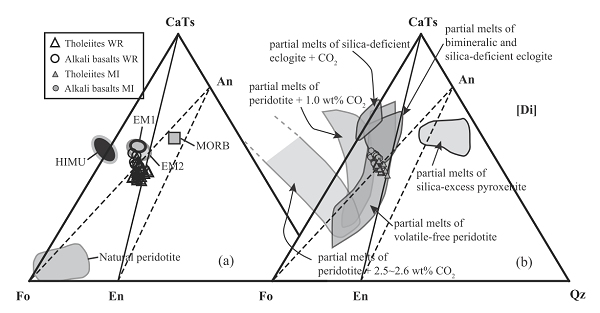广州地化所利用橄榄石中的熔体包裹体来研究海南新生代玄武岩成因取得新发现
目前国内外对火山岩成因方面的研究成果主要通过火山岩的全岩地球化学分析手段获得。然而火山岩的全岩成份反映的不仅是原生岩浆的成分,还反映了岩浆形成到喷发过程中的一系列岩浆后期作用的影响,如不同来源岩浆的混合、结晶分异及同化混染等作用对岩浆成分的影响。致使原生岩浆成分及其演化、源区母岩方面的重要信息等变得模糊或消失。这给岩石学的成因方面的研究带来较大的困难。与全岩成分不同,岩浆中较早结晶的橄榄石中的熔融包裹体能较好地记录原生岩浆的成分、岩浆演化以及岩浆来源方面的重要信息。
中国科学院广州地球化学研究所同位素地球化学国家重点实验室的硕士生刘建强(已毕业)在任钟元研究员的指导下,对海南岛晚新生代玄武岩橄榄石中的熔体包裹体进行了化学成分分析,发现拉斑玄武质的熔体包裹体和碱性玄武质熔体包裹体存在于同一个岩石样品中,而且在该地区的拉班玄武岩和碱性玄武岩全岩样品中普遍存在此现象。这在国际岩石学界尚属首次发现。根据熔体包裹体地球化学特征,结合实验岩石学的研究成果,该课题组将这一地质现象解释为深部岩浆房之下来源于深度不同、部分熔融程度不同的地幔熔融区产生的碱性玄武质和拉班玄武质的熔体,上升进入到上方深部岩浆房中发生不一致的岩浆混合作用所致。
该研究成果已发表在国际著名地学期刊GCA中。
Jian-Qiang Liu, Zhong-Yuan Ren*, Mao-Shuang Song, Sheng-Ping Qian, Yan Zhang, Pei-Pei Zhao. Petrogenesis of Late Cenozoic Basalts from North Hainan Island: Contraints from Melt Inclusions and Their Host Olivines. Geochimica Et Cosmochimica Acta 152, 89-121 (2015).
(http://www.sciencedirect.com/science/article/pii/S0016703714007443)
Abstract
Melt inclusions and their host olivines in basaltic lavas provide important information about the nature of their mantle source. We present the first analyzed chemical data of olivine-hosted melt inclusions in Cenozoic basalts from the North Hainan Island and report the discovery of both tholeiitic and alkalic melt inclusions in a single rock sample. Cenozoic basalts from the Hainan Island are predominantly tholeiites with only small amounts of alkali basalts. There is a much broader compositional variation in melt inclusions than whole rocks. Compared to partial melts of mantle peridotite, the Hainan basalts have lower CaO, Na2O/TiO2, CaO/Al2O3 and Co/Fe, and higher TiO2, FeO?, Fe/Mn, Zn/Fe and Zn/Mn. The olivine phenocrysts from the Hainan basalts contain lower Ca and Mn, and higher Ni and Fe/Mn than those of olivines crystallized from partial melts of peridotite. Projections from or towards olivine into the plane CS-MS-A for melt inclusions and whole rocks with MgO >7.5 wt% imply that the residual minerals in the source of the tholeiites are mainly clinopyroxene and garnet, possibly with some orthopyroxene, while in the source of the alkali basalts they are dominated by clinopyroxene and garnet. This indicates that a pyroxenite component could serve as the source lithology of the Hainan basalts. The OIB-like trace element compositions, with Ba, Sr, Nb and Ta positive anomalies, and Th and U negative anomalies, of the Hainan basalts suggest that a recycled oceanic crust component was involved in the source of the Hainan basalts. Based on a CMAS projection of primary magma compositions of the whole rocks and melt inclusions, we infer that a stage-2 silica-deficient pyroxenite derived from melt–peridotite reaction or mechanical mixing between recycled oceanic crust and peridotite can serve as the source lithology. Partial melts derived from such a source can match the overall compositions of the Hainan basalts better than those of MORB-eclogite and fertile peridotite. The compositional range from tholeiitic to alkalic basalts is ascribed to decreasing degrees of melting of a similar silica-deficient pyroxenite source, which is consistent with the lower incompatible trace element and REE abundances in the tholeiites compared to the alkali basalts. Both subalkaline and alkaline melt inclusions are present in a single sample, which indicates that magma mixing had occurred in the deep magma chamber prior to eruption below the Hainan Island.

图1 单一岩石样品中的熔体包裹体(铁丢失校正)与其寄主全岩的TAS图解。拉斑质的熔体包裹体和碱性的熔体包裹体被发现存在于同一个样品中,这种现象在国际岩石学界尚属首次发现 
图2 经过橄榄石分离校正的海南岛原始岩浆组成的CMAS投图
同位素地球化学国家重点实验室和广州地化所科技处供稿

 新闻动态
新闻动态
